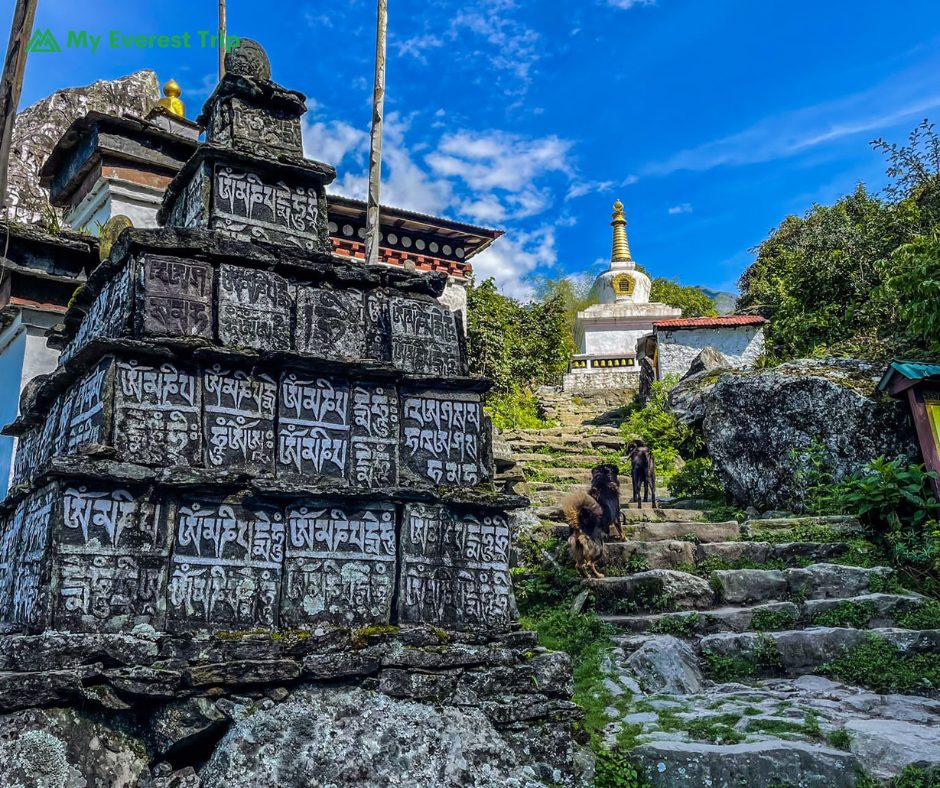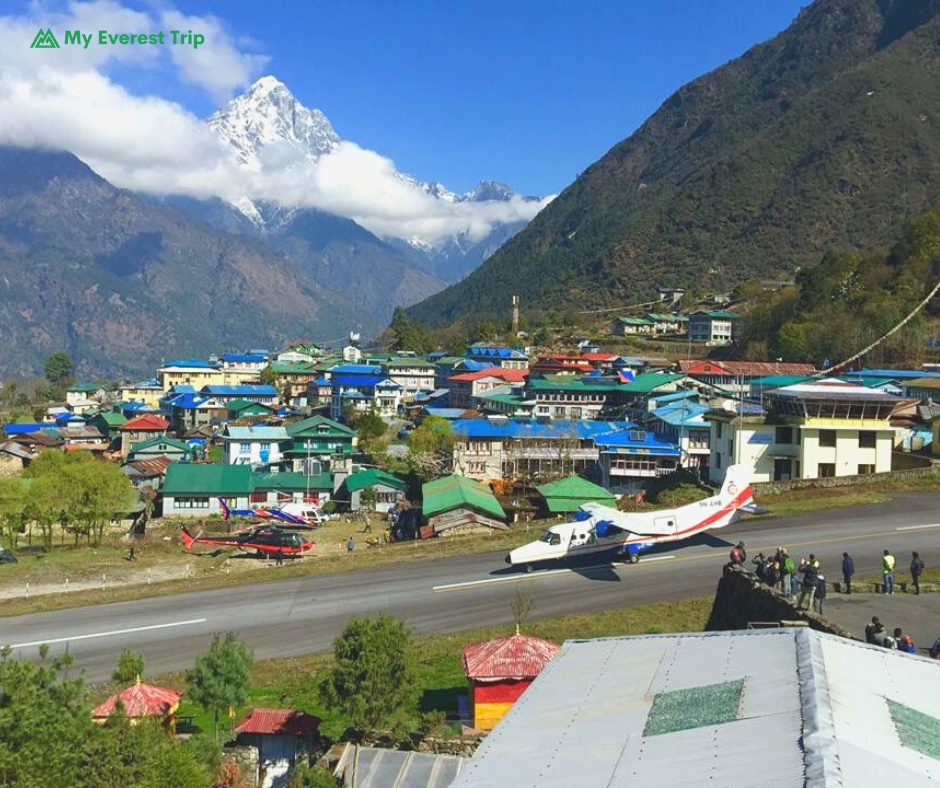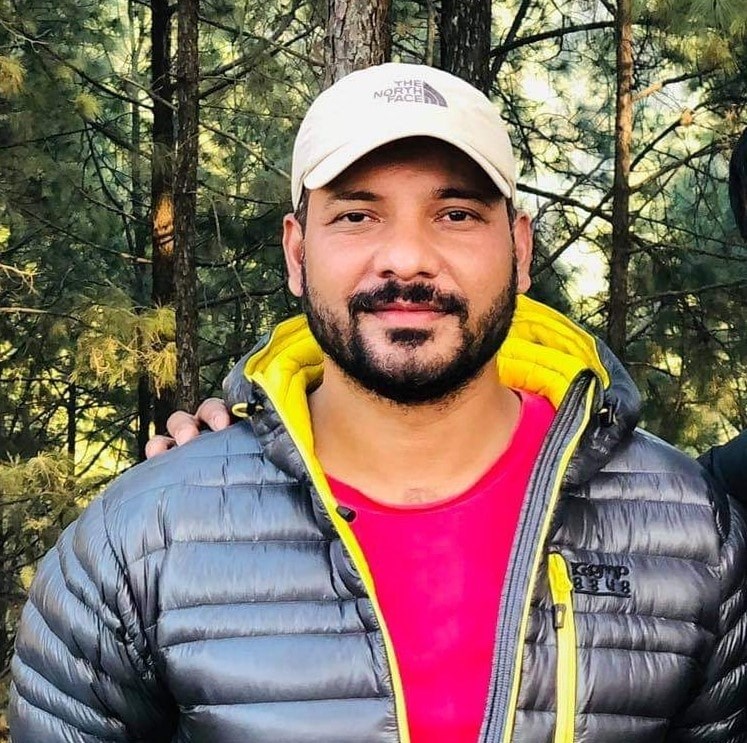Table of Contents
Everest Base Camp Trek Guide
Everest Base Camp Trek Guide? know how it feels to stand before the world’s tallest mountain and scream “I love my life” with all your voice? Do you want to know what wandering on the remote Sherpa Villages and glacier lakes feels like?
These are the dreams we all often live with; however, we fear executing. So, if you are also one of those wanderlust souls who wish to conquer Mount Everest by Everest Base Camp Trek, this article will help you.
Thousands of adventure lovers from around the globe have already made this journey to the base of the world’s tallest mountain. The impactful spiritual power of Everest draws trekkers to its proximity. And now it’s your turn.
Everest Base Camp Trek Guide, let us help you with “Where Is Mount Everest?” Standing proudly at 8848 meters, Mount Everest is the world’s highest peak. That lies in the Solukhumbu district of Nepal. Trekking to its base camp (5,364 m/ 17,598 ft) is one of the world’s most popular trekking routes. Everest Base camp begins once you get to Kathmandu, Nepal, and then fly to Lukla airport. From Lukla, it is almost ten days of walking to and from Mount Everest Base camp, completing the journey of about 130 km.
Read this article to the end and learn about the Mt. Everest Base Camp trek.
How hard is it to walk to Everest Base Camp?
Do not expect getting above 5,000 meters and standing before the Majestic Himalayas to be a leisurely tour. Technically, Everest Base Camp is a moderately strenuous hike. It is easier than many other base camp treks of Nepal, including Manaslu, Makalu, and Kanchenjunga. There’s no need for any mountaineering skills and thus be completed by trekkers without high-altitude trekking experience. Whether it’s your first time heading to the mountains or let it be just one of your unlimited endeavors, the EBC trek fits all.
Here are some Everest Base Camp trek difficulties one encounter and ways to solve them.
Walking
Mount Everest Base camp trek is about 130 km, and you must complete this distance in 10 days. This means one shall cover 10 to 15 km each day. Although walking a mere km in a day is not a big deal, hiking on steep and rough terrain can be demanding. Especially when you carry a heavy bag and walk beyond 4,000 meters, even taking a few steps can be challenging.
So, if you ask, “Is Everest Base Camp trek difficult,” the answer is yes, it is difficult, but not impossible. All you need is the proper guidance and preparation. One must prepare for the Mt. Everest Base Camp trek with cardio exercises before there. 3-4 months before there, you will find this trek an easy victory if you start light running, jogging, cycling, swimming, and squats.
Here’s the short Everest Base Camp Trek Itinerary and the distance you must cover daily.
- Day 1: Fly to Lukla and hike to Phakding – 9 km (4 hours)
- Day 2: Trek to Namche Bazaar – 12 km (6 hours)
- Day 3: Rest in Namche
- Day 4: Trek Tengboche – 10 km (6 hours)
- Day 5: Trek to Dingboche – 12 km (6 hours)
- Day 6: Acclimatization in Dingboche
- Day 7: Trek to Lobuche – 12 km (7 hours)
- Day 8: Trek to EBC and back to Gorak Shep– 15 km (8 hours)
- Day 09: Trek to Kala Pathar and Pheriche – 13 km (7 hours)
- Day 10: Trek to Namche Bazaar – 14 km (8 hours)
- Day 11: Trek to Lukla – 15 km (8 hours)
- Day 12: Fly back to Kathmandu
Altitude: One of the tricky things about this Everest Base trek is coping with the high altitude. Here’s the list of many different places on Everest and the eight de.
- Kathmandu’s elevation is 1300 m / 4265 ft
- Lukla’s elevation is 2,860 m/ 9,334ft
- Phakding elevation is 2652 m / 8700 ft
- Namche Bazaar’s elevation is 3440 m / 11286 ft
- Tengboche’s elevation is 3870 m / 12696 ft
- Dingboche elevation is 4360 m / 14304 ft – 5 to 6 hrs
- Lobuche elevation is 4940m / 16207 ft
- Gorakshep’s elevation is 5368m / 17611 ft
- Everest base camp elevation is 5,364m/ 17,598 ft
- Kalapatthar’s height elevation is 5,644.5 m/ 18,519 ft
- Pheriche elevation is 5545m / 18192 ft
Once you fly to Lukla, you already get closer to the mountains. Above Tengboche, you can feel the effect of altitude. When the pressure of oxygen drops, you can feel difficulty breathing. You might develop the symptoms such as Headache, Feeling sick, Dizziness, Tiredness, Loss of appetite, Shortness of breath, and even Fainting. It might even get worst with a loss of coordination and tightness in the chest, cough, etc.
Tips to overcome altitude sickness
- Keep at least two acclimatization days, i.e. one in Namche and the other in Dingboche (cover less than 1000 meters each day)
- Stroll and rest long when you feel tired; there’s no need to rush.
- Make sure you drink a lot of warm water (3-4 l/ day) and avoid all kinds of alcoholic drinks so that you are hydrated.
- Eat only a healthy, high-calorie diet at a definite interval
- If you start feeling sick, stop the climb, and descend to a lower altitude. Carry medicines such as acetazolamide (for altitude) and ibuprofen/ paracetamol for the pain.
Weather and climate
Everest Base Camp Trek Guide most accessible hike to Everest Base Camp can be done in the stable and calm weather of autumn and Spring. During these months, the temperature of Everest also rises to about 5 degrees Celsius. Few chances of rainfall and snow make treks to Everest easy. So, it’s suggested that you travel between September to November and March to May.
If you trek in winter, carry boots and crampons, and don’t travel solo. A sleeping bag is compulsory and takes clothes in layers.
The mountains are cold, and the weather there is volatile. Without a doubt, Everest weather is freezing year-round, with a thick layer of snow in winter. Winter has an average temperature of -5 to -15 degrees, making it almost impossible to trek. Although the Himalayas look magnificent, winter hiking in the snow isn’t easy. Summer is warm, but the rainfall makes the trail slippery. Also, there are mosquitoes and leeches, adding to the difficulty.
Remoteness
The remoteness and lifestyle of people living in the Himalayas might be something you might have never imagined. For these 12 days, you will be living with limited resources. Trekking makes you sweaty/ dirty, and you might not get to shower at the end of each day. You don’t get to buy clothes or personal care items once you get above Namche. There’s not even ATMine once you start the hike.
The Everest Base Camp hike accommodation, is fundamental, with cozy rooms and small beds. The rooms might not have private bathrooms above Namche. They serve Nepalese, Indian, Chinese, and continental foods from fresh vegetables and cereals.
Weight of your bag
The weight of every food, clothes, and trek item in your bag reaches almost 15 kg. And carrying this weight for 12 days while walking on the steep land is not easy. Packing-wise and hiring a porter to carry your bag makes the trip easy. While you book your trek with MyEverestTrip, there will already be a porter.
Financial difficulties
Well, it’s just a warning that you manage your finance well—the Everest base camp trek costs between $1200 to $2000 (quite affordable). The well-arranged Everest trek package is worth about $1500, and you will need $500 to $1000 more for tips, donations, drinks, and snacks. Make sure you arrange this money.
How much does it cost to trek to Everest Base Camp?
The Cost depends on where you book your trip. The International Trip operators can cost between USD 2500 to 5000/ per person, which is way above your actual Cost. Local travel agencies like MyEverestTrip offer the most reasonable Everest Base Camp trek cost of $1400 to $1800/ person. This includes the flight to guide, food, accommodation, and permit.
Walking the streets of Thamel, you can also get cheap Everest base camp packages ranging from $700 to $1200. But since their package will skip many things, you will spend from your pocket. Independent trekkers traveling in a group might be able to travel for about $1200, but the hassle of arranging your trip can be overwhelming.
Along with the Everest base camp cost included in the package, there will be $500 to $1000 expenses of your own. This consists of the Cost of tips, donations, drinks, water, and other food you crave for. Nowadays, the travel agency of Nepal is offering Luxury Everest Base Camp that offers better hotels and meals. Still, the price of the Everest Base Camp trek is almost two times, i.e. $3000.
There are two kinds of Cost, i.e. One-time Cost, which includes flight cost, permit fee, and trekking gear cost. And then there’s a flexible cost which provides food, accommodation, guide/ porter, Wi-Fi, etc., which depends on your Itinerary and increases with a more extended stay.
Everest base camp permit cost
- Three kinds of permit cost, i.e. Nepalese Visa, National Park entry permit, and Local area permit.
- For foreigners
- Visa Cost: USD 30 for 15-day multiple entry visas and USD 50 for 30-day multiple entry visa
- Sagarmatha National Park entry permit Cost: USD 30
- Khumbu Pasang Lhamu Rural Municipality Entrance Permit Cost: NPR 2000 ($20).
- For SAARC country
- No Visa Cost
- Sagarmatha National Park entry permit Cost: Rs 600
- Khumbu Pasang Lhamu Rural Municipality Entrance Permit Cost: NPR 2000 ($20).
Kathmandu to Lukla flight cost
The one-way Cost of the Lukla flight is $187 per person for foreigners, and for Indians, It’s 14,700 per person.
Cost of trekking gear
Buying all trekking gear can range from $500 to $2000, depending on the brand. However, you can rent them for $2 to $3 per day per item in Thamel. The Cost depends on what you need.
Everest Base Camp Trek Guide Cost and Porter
For a porter and Guide on Everest, the Cost per day is $20 to $25; for a guide, it is $25 to $30. For a 12 days trek, that shall be $240 to $300 for a porter and $300 to $360 for a guide.
Note: The price of Everest Base Camp depends on Your Itinerary. For the classic 12 days tour, you spend about $1500. A short Everest trek can be done in 9 days, costing $1200. Sometimes, trekkers add three pass trek and Gokyo take, which cost $2500 and $2000, respectively. In short, if you stay longer, each day adds $80 to $100 (including porter, guide, and hotel costs) to your budget.
Some tips for saving Cost
- You can sometimes negotiate for a lower room price when you eat in the tea house you stay in, instead of having many items, order one fulfilling food (like Dal Bhat).
- Carry sterilizing tablets and water of your own. Also, keep some chocolates, juices, energy drinks, snacks, etc., in your bag.
- Travel in a group so that you can save costs on Guide and porter
- Using an Everest Link card or NCELL SIM card data saves a lot.
How long is the Everest base camp trek?
Flying to Kathmandu and staying here for a few days is your choice. This time depends on how far your country is and how many days you need for preparation in Kathmandu. A few days in Kathmandu for shopping, renting trek gear, sightseeing, and understanding Nepalese culture is a very fruitful thing to do.
Now, let’s count the time once you get to Lukla. Flight to Lukla airport from Kathmandu is only about 30-mins and operates regularly throughout the year. From Lukla, the trek is 8 to 12 days depending on your speed. A standard Everest Base Camp trek package from MyEverestTrip is 14 days from your arrival. From Lukla, our EBC Itinerary is 11 days long, giving you enough time to acclimatize and stroll.
Experienced trek prefers a short Everest base camp package of 7 to 9 days from Lukla. However, we don’t recommend such short Everest tours for anyone other than professionals. If you do that, the risk of altitude sickness is very high.
Trekking to Everest Base Camp from Jiri
Although rare, some tourists prefer to trek to Everest Base Camp from Jiri and skip the flight to Lukla. For that, you spend one full day driving to Bhandara. From there, it takes you 5 to 6 days to join the classic Everest Base Camp route at Phakding. And if you also skip the return flight, it will add three more days. The Everest Base Camp trek from Jiri is about 20 days long.
Other treks in Everest
Adding some places and skipping a few classes along the route can add to or lower your Everest Base camp trek time. For example, the trekkers often head for Gokyo Lake Trek, which is 16 days long from Kathmandu itself, and adding Everest Base Camp Trek and Gokyo Lake Trek makes it about 20 days. Also, there is another Everest Three Pass Trek that is about 17 days.
Tips: Don’t rush; this journey is a once-a-lifetime, so take your time. Although the trek is only ten days long, you can take a month-long vacation. You can add a few days to your trip by staying for a few days in Namche, Tengboche, and even Gorakshep. Hike to nearby hills and experience the culture.
Is Trekking to Everest Base Camp worth it?
Yes, Everest is worth all pain and sweat you face on this tour. This is the busiest trekking route in the world for many reasons. Here is why the Everest Base Camp trek is worth it.
Mountain View: The first and foremost reason is the soaring mountain view that looks magical. You will see Mt. Everest standing high and proud. Together, there shall be other mountains to witness, i.e. Lhotse (8,516 meters), Makalu (8,485 meters), Cho Oyu (8,188 meters), and many other small peaks. You will see this spectacular view from not just Everest Base Camp but many different magical viewpoints like Kala Patthar (Kalapathar), Everest View Hotels, and Nangkar Tsang / Dingboche Viewpoint. The sunrise view with the mountains before you will be magical.
Sagarmatha National Park: The rich bio-diversity of Nepal is preserved in the Sagarmatha National Park- a renowned World Heritage site. On the trek, you can encounter Himalayan Thar, Snow Leopard, Red Panda, Monkey, and many birds. While staying at the Namche Bazaar, you can visit this beautiful museum.
Namche Bazaar: This stunning town in the Everest region is equally exciting. With many great restaurants, bars, and a bakery, it’s a place to relax and enjoy. You visit many other villages, hear by, and interact with locals during your stay here. Also, there is Museum, Edmund Hillary schools, and a local hospital to visit.
Cultural insight: The life and culture of people living on Everest might be something you have never known or heard of. The Sherpa are the bravest and most peaceful people living in the hidden villages of Khumbu. They even let you borrow their clothes and let you cook some of the traditional foods in the Kitchen. You can form a group and even enjoy dancing and singing in the hotels on Everest you are staying at. You get to live their lifestyle, pray at their monasteries, and understand life differently.
Tengboche Monastery: This oldest monastery, called Thyangboche Monastery or Dawa Choling Gompa, is also an exciting place to visit. You can join the evening prayer and light candles. A visit here blesses you with calmness and happiness.
Find peace: Strolling with pristine waterfalls and rivers, listing to the birds chirping, and hiding within the mountain, will help you discover yourself. This trip will surely fill you with joy and peace, rejuvenating your core.
So, Yes, IT IS ALL WORTH IT.
How do you poop on Everest?
Though wired, this is one of the most searched online questions. And let us answer that one for you.
We will stay in quite comfortable hotels during the Everest Base Camp trek. So, the bathroom is not an issue. This might be a problem for mountain climbers who always travel with a tented camp. While camping, the trekkers poop in a hole toilet, making small holes in nearby places and closing it when done. Sometimes, they also use wag bags or poop tubes.
How do you go to the toilet on Everest?
Hotels up to Namche Bazaar has rooms with private bathroom and Western-style seats. They even have hot showers and toilet amenities. So that’s not a big issue.
Above Namche to Gorakshep, the landscape becomes difficult, and accommodation becomes basic. So, naturally, you will have to use bathrooms on sharing basis, and sometimes, they have squat seats. Hopefully, it’s clean.
Final Say,
So, do you have any more questions for MyEverestTrip regarding your Everest endeavors? If you have more queries, we will happily address them. Just leave a comment below us and send us an email.
We are excited to be hearing from you.






